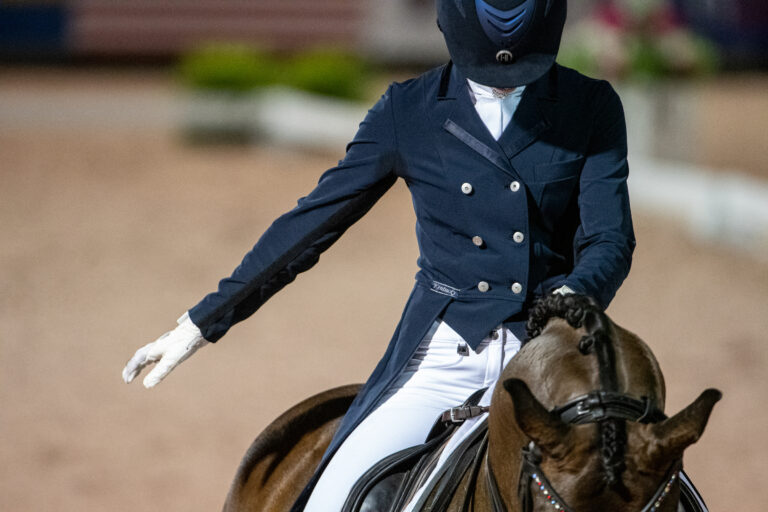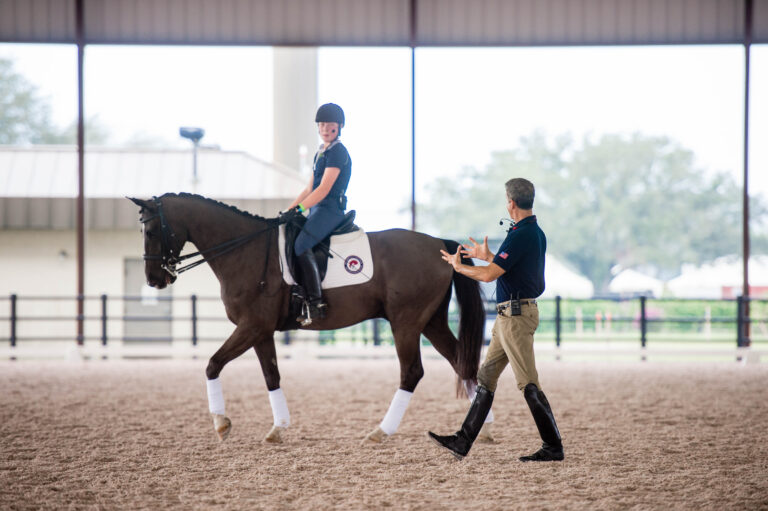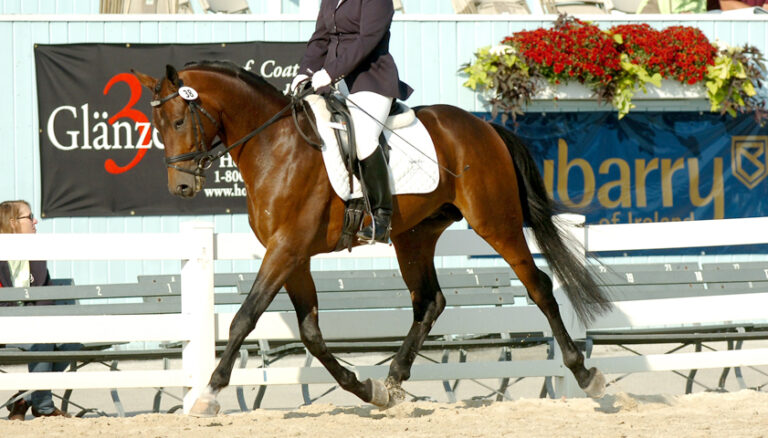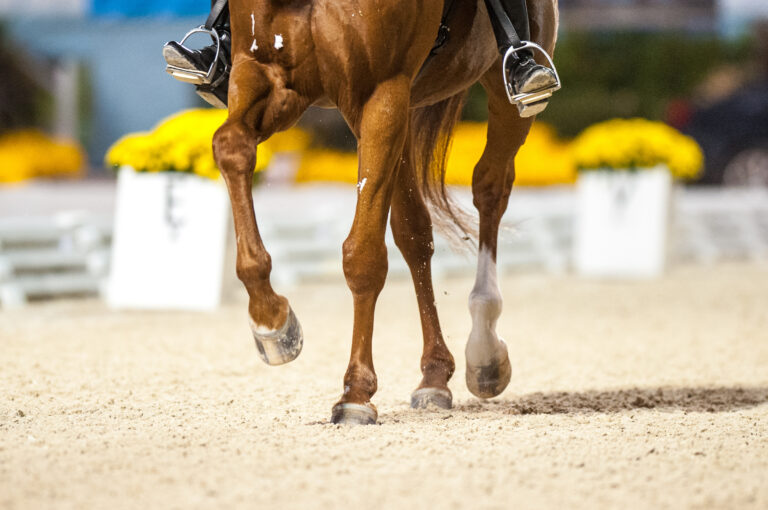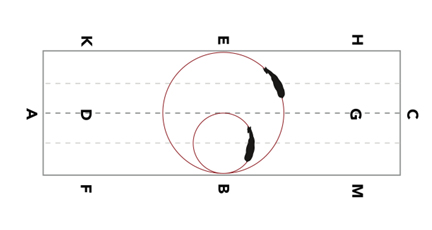Stretching, regardless of your horse’s age, is a test of his relaxation, looseness, self-carriage and balance under the weight of a rider. Stretching also develops those qualities as it tests them. Stretching can be performed at walk, trot or canter and, when done correctly, it lifts the horse’s back under the rider to create freedom and swing.
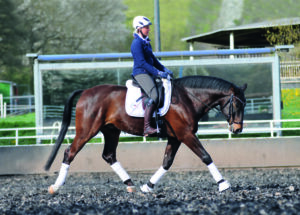
Young horses need to get used to the weight of the rider, and all horses need to stretch to ensure that the rider is carried with the horse’s back instead of his legs.
When a horse is moving correctly, his back is soft and round under the rider’s seat and he carries the rider’s weight with his back—making him a “back mover.” In the opposite situation, the horse’s back is stiff and dropped down; the rider is sitting in a pit, so the horse has to carry that rider’s weight with his legs—making him a “leg mover.” Stretching lifts the horse’s back and helps him be a back mover instead of a leg mover.
How Stretching Lifts the Back
First, your horse has to reach toward the bit with his head and neck as well as with his hindquarters. Second, your horse has to engage, or bend, the joints of his hindquarters and carry weight. Activity of the horse’s hindquarters, with reach and engagement, help the horse move with his balance more toward the hindquarters. The horse lifts his back, providing a loose, swinging place for the rider to sit comfortably.
Here’s how you can tell if your horse’s back is being used correctly:
• It’s easy to sit because his muscles are loose and his back swings.
• His footfall is soft and light because he carries your weight with his back instead of his legs. When the back is hollow, the legs have to do all the work of carrying the rider, so they hit the ground harder.
• The muscles at the base of your horse’s neck, in front of the withers, are engaged, so the base of the neck becomes wide.
• Ideally in a stretch, your horse’s nose is in front of the vertical and level with the point of his shoulder.
Some horses are more natural back movers and more able to stretch because of their conformation and way of moving. Circumstances also influence your horse’s ability to stretch. At home where your horse is comfortable, it’s probably easier to achieve a relaxed stretch. In more challenging circumstances—at a horse show, a clinic or any environment where your horse feels nervous—it may be more difficult.
The Balance of the Rider’s Body
If you don’t have an independent seat, then it’s very difficult to get self-carriage in your horse. The rider must be balanced over the center of gravity of the horse—not behind the motion or ahead of it. When the rider is too far forward, it puts the horse on the forehand. When the rider is too far back, it pushes the horse’s back down and the hind legs out behind him. Both situations make it difficult to achieve balance in the horse.
The rider’s balance is controlled by her core muscles, which are as important as the core muscles of the horse. A rider sometimes thinks only about her own core muscles but fails to remember that if the horse isn’t using his back correctly, it is difficult to find a place to sit (see “Learning to Sit” below). It takes both horse and rider. If you focus only on yourself and the way you sit, the horse won’t magically use himself correctly. I say to my students: You have to create a place to sit. The horse has to correctly thrust and engage from behind, lift his back and use his core for you to have a place to sit and to use your body correctly.
Learning to Sit
I have taught many beginner riders who are learning to sit the trot. A beginner’s horse should be in side reins and on a longe line because then the horse has a chance to be round in the topline. I often see riders who are new to the sport trying to learn to sit the trot when the horse is hollow and they don’t have a positive experience because they’re trying to prevent the hollowing and end up riding from front to back.
I feel this is a missing link in North America. Learning to sit is not easy, so I believe that all beginners should start on a longe line with correctly fitted side reins so the horse’s back is up. Later, when the rider has learned how to sit and has felt the horse’s back up, she has a chance to create an environment in which she can sit when she is off the longe line. If the rider has never felt the correct seat, it’s nearly impossible to create that environment. Educated instructors know basic longeing skills and should know how to fit side reins correctly.
Chewing
Light chewing with the mouth closed creates foam in the horse’s mouth, and you ideally want to maintain that same chewing in all frames, whether stretching or not. Chewing is a sign of relaxation and it indicates that your horse is using his body in a positive way.
How to Shorten and Lengthen the Stride
How to lengthen: Push your horse forward with the leg into both hands. When you feel the thrusting of the hind legs in your hand, relax the contact slightly without dropping it. Your horse should reach for the bit and lengthen both his stride and frame. Your horse might be inclined to become quick and lose his balance onto the forehand, but your half halts should regulate the tempo and the balance.
How to shorten in a forward way: The most important aspect of this shortening of the stride (which is a downward transition) is to keep the forward desire. If your horse loses energy and impulsion when you shorten, there is no longer a connection to your hand. Correct half halts create increased thrust and engagement, but they contain the energy by controlling the speed. The result is a greater degree of balance (weight) toward the hind legs into the direction of collection. Then the rider softens to allow self-carriage in the better balance. Half halts regulate the balance and the tempo just as they did in the upward transitions.
Exercise: The Stretch
Set yourself up for success by first developing a good connection. When you have positive tension in the connection, you have something to release into the stretch. If you don’t have that connection, you can’t get an honest stretch. Begin on a 20-meter circle in a normal working trot rising.
Step 1. Do small transitions forward to a slight lengthening and back to working trot again, emphasizing the reach of your horse’s hind legs under his center of gravity and feeling for the connection to your hand. Make your requests modest. The most important aspect of this exercise is getting a good response to the forward-driving aids and to the aids for the downward transition to working trot that must happen in a way that you keep the forward desire. The breakdown often occurs in the downward transition when the horse loses energy and impulsion, thereby losing the connection to the rider’s hand. Then it will be difficult to achieve an honest stretch.
Step 2. Check to be sure you have a good feeling in your hand—that the horse isn’t against your hand (which would mean he’s on the forehand) and he’s not curling behind the bit and too light in the contact. You want to feel that your horse is stepping to your hand and drawing on the rein with positive tension.
Step 3. Gradually push your hand forward and down to let your horse stretch and chew the reins. The quality of the connection beforehand determines how much you can let the reins out without sacrificing the connection, the energy and the swing. For some horses who are new to stretching, it might only be a few inches. It’s most important to retain the quality of the connection. If it feels easy, you can increase both the amount of the stretch and the duration of it, which also depends on the quality of the connection.
Step 4. From the stretch, you have two options:
1. Regather the reins gradually and return to that same quality working trot as is required in your dressage tests. Concentrate on keeping the forward energy so your horse doesn’t slow down or speed up.
2. From a good positive stretch, let your horse chew the reins out into a walk. Ask for this with your voice and your seat. Sit tall but not too heavily because you don’t want to push your horse’s back down. This is my favorite thing to do at the end of the ride when my horse is done for the day.

A Few Misconceptions
1. Some riders, when asking the horse to stretch, think that if they wait it out, the stretch will magically happen. It’s actually the exact opposite. You have to create positive tension in order to have the release of that positive tension to create the stretch.
2. Many riders make the mistake of riding with a loose rein, which is the nemesis for moving forward. If the connection is not achieved, then the stretch and also further development will not be achieved.
3. Even if horse and rider are not ready for collection, the principles behind collection need to be developed along with the qualities of the Training Scale. There must be the growing possibility of collection.
Through the Levels
As your horse develops, you’ll find other tests for his self-carriage and relaxation. For example, in the FEI 7-year-old test, the stretch is done in the sitting trot. (It was previously done rising.) In the canter, we have Überstreichen, in which the release of one or both reins demonstrates your horse’s self-carriage, balance and relaxation.
The stretch rising and sitting are related to Überstreichen because the prerequisites for all these tests are the same:
• The engagement of the horse’s hindquarters.
• The lifting of his back
• The engagement of his core muscles.
When you can keep these qualities, you have a place to sit and you can demonstrate your horse’s self-carriage at any time. It is essential to gymnasticize your horse by stretching and collecting throughout your training sessions to achieve the suppleness and contact required at all levels.
9 Tips to a Successful Partnership with Your Horse
1. Be well prepared. Have a game plan for training so your horse understands and doesn’t become nervous or frustrated. If you don’t know where you’re going, it’s difficult to get there. Take a look at your map and prepare.
2. Be calm and confident. Make sure your horse trusts you 100 percent before you start training. Hand-walking, grooming and grazing are as important as time in the saddle. Build your relationship. Horses pick up on your feelings easily. If you’re in a hurry and just throw your tack on, it often doesn’t end well.
3. Train without time constraints. Give yourself enough time so you aren’t in a hurry during your training session. If you’re short on time, it might be better to go on a hack or do stretching exercises instead of a training session. That’s common sense but not everyone uses it!
4. Be clear in what you want. Avoid any gray area. Be black and white with the questions you ask. That leads to fairness because when the horse knows the expectation, he’s more willing to perform what you’re asking.
5. Set small, specific goals. Throughout my ride, I set goals. When I do a transition to halt, I’m setting goals and asking myself: Is the halt square? Is my horse’s neck round? Is his response immediate? Does he stay attentive to me with his ears back? Then I build upon that throughout the training session.
6. Listen to your horse. Training is communication. Observe subtle things and feel how your horse responds. For instance, your horse’s ears tell you a lot. If they are forward all the time, perhaps he’s not paying attention. Learn to pick up on the subtle cues.
7. Be open-minded. My best teachers have been my horses. Having an open mind when you get on your horse allows you to be open to listening and learning and keeps you from having an ego that’s too big. People, especially at a horse show, often change the way they’re riding and then they’re not in it for the right reasons.
8. Have fun. It’s easy to forget why we’re doing this, especially when we get competitive. Be in the moment with your horse and don’t take that for granted. Be happy with your progress—even if it’s small.
9. Be grateful. Every day is a gift. I try to remember that and be grateful to the horse. When the horse responds, it means he understands. Know that what we’re asking the horse to do is a lot. If we’re too demanding it can be frustrating for both the horse and rider.
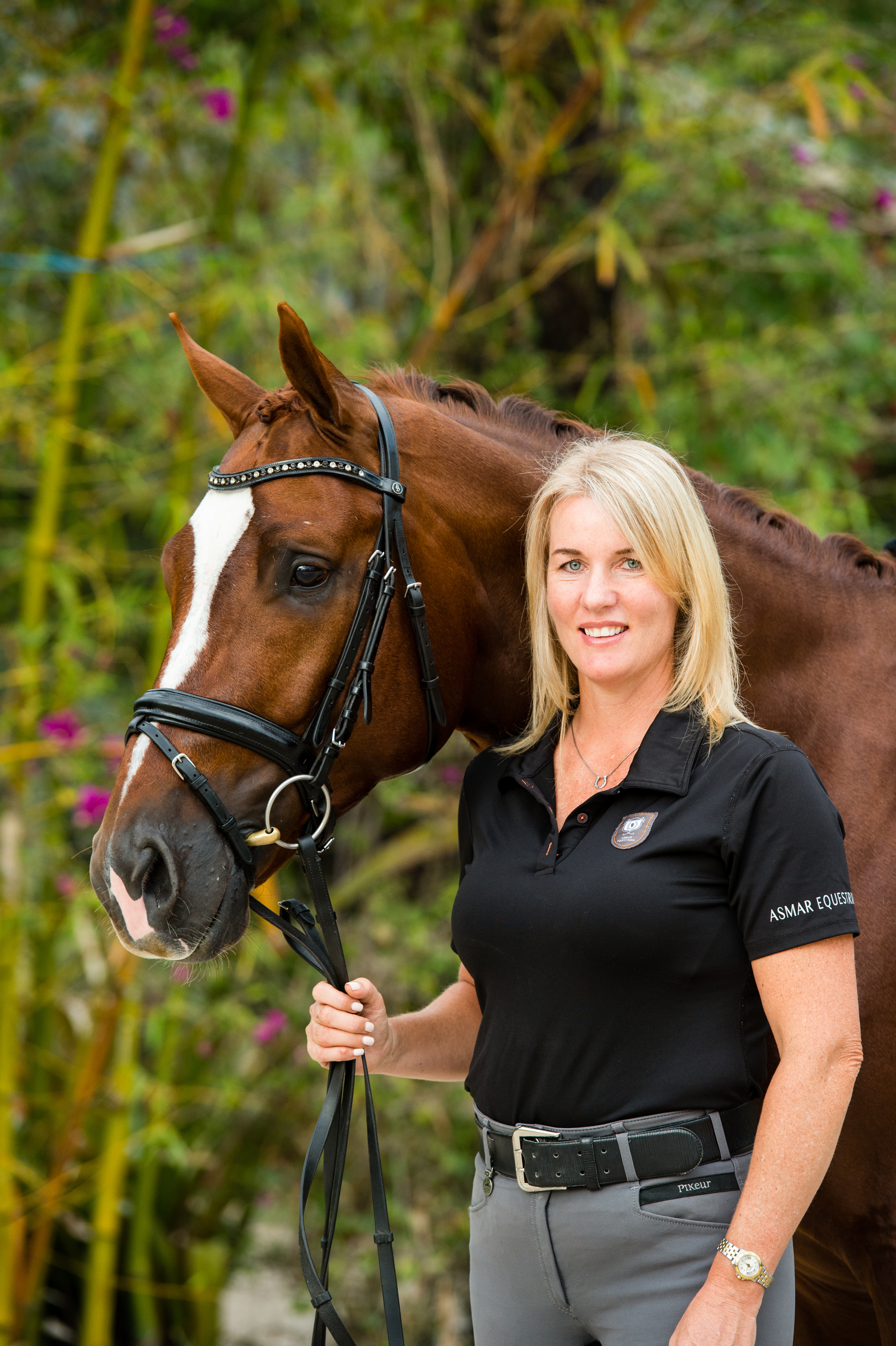
Karen Pavicic is an international dressage rider and Canadian high-performance dressage coach. Since 1988, Pavicic has represented Canada multiple times as a listed athlete on the Canadian Equestrian Team. Highlights of her career to date include being a member of the Canadian silver-medal team at the 2007 Pan Am Games in Rio de Janeiro, Brazil, and a member of the 2014 Canadian World Equestrian Games Team in Normandy, France. She and her horse, Don Daiquiri, were also named as the reserve combination for the 2015 Pan American Games and the 2016 Olympic Games. Pavicic has successfully trained numerous horses to the FEI level and enjoys guiding her students to success at home and in the show ring.
For More:
- For more on the importance of stretching and additional exercises, click here.
- Click here to watch video demonstrations on stretching exercises for the dressage horse on EQUESTRIAN+.


